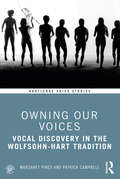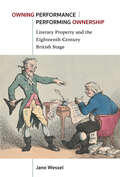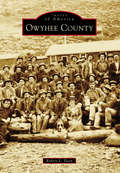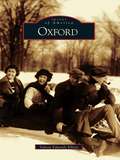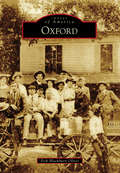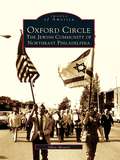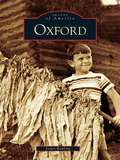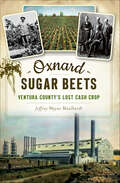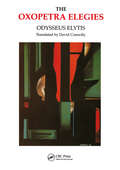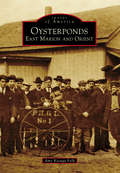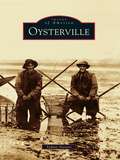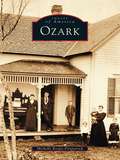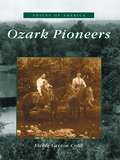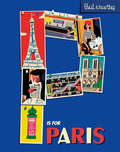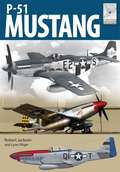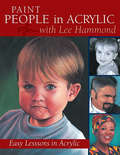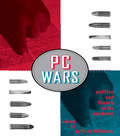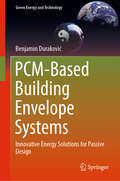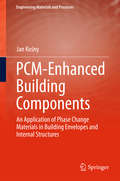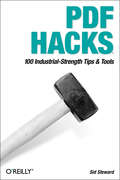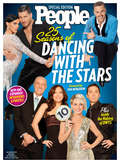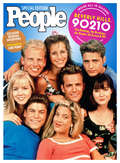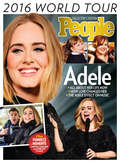- Table View
- List View
Owning Our Voices: Vocal Discovery in the Wolfsohn-Hart Tradition (Routledge Voice Studies)
by Patrick Campbell Margaret PikesOwning Our Voices offers a unique, first-hand account of working within the Wolfsohn-Hart tradition of extended voice work by Margaret Pikes, an acclaimed voice teacher and founder member of the Roy Hart Theatre. This dynamic publication fuses Pikes’ personal account of her own vocal journey as a woman within this, at times, male-dominated tradition, alongside an overview of her particular pedagogical approach to voice work, and is accompanied by digital footage of Pikes at work in the studio with artist-collaborators and written descriptions of scenarios for teaching. For the first time, Margaret Pikes’ uniquely holistic approach to developing the expressive voice through sounding, speech, song and movement has been documented in text and on film, offering readers an introduction to both the philosophy and the practice of Wolfsohn-Hart voice work. Owning Our Voices is a vital book for scholars and students of voice studies and practitioners of vocal performance: it represents a synthesis of a life’s work exploring the expressive potential of the human voice, illuminating an important lineage of vocal training, which remains influential to this day.
Owning Performance | Performing Ownership: Literary Property and the Eighteenth-Century British Stage
by Jane WesselIn 1710, England’s first copyright law gave authors the ability to own their works, but it was not until 1833 that literary property law was extended to protect dramatic performance. Between these dates, generations of playwrights grappled for control over their intellectual property in a cultural and legal environment that treated print differently from performance. As ownership became a central concern for many, actors fought to possess their dramatic parts exclusively, playwrights struggled to control and profit from repeat performances of their works, and managers tried to gain a monopoly over the performance of profitable plays. Owning Performance follows the careers of some of the 18th century’s most influential playwrights, actors, and theater managers as they vied for control over the period’s most popular shows. Without protection for dramatic literary property, these figures developed creative extra-legal strategies for controlling the performance of drama—quite literally performing their ownership. Their various strategies resulted in a culture of ephemerality, with many of the period’s most popular works existing only in performance and manuscript copies. Author Jane Wessel explores how playwrights and actors developed strategies for owning their works and how, in turn, theater managers appropriated these strategies, putting constant pressure on artists to innovate. Owning Performance reveals the wide-reaching effects of property law on theatrical culture, tracing a turn away from print that affected the circulation, preservation, and legacy of 18th century drama.
Owyhee County
by Robert L. DeenThe sprawling high desert wilderness of southwestern Idaho was virtually unknown to whites in 1863, when Mike Jordan and a band of placer miners dipped their pans into the creek that bears his name and found gold. The electrifying news spread, and the people came. Towns sprang up overnight on the mountaintops. Some disappeared almost as quickly as they had appeared. "Men needed to work the mines!" cried Idaho's newspapers. The word went out, and the miners came from Nevada, California, Colorado, and across the West. Soon the great mines of War Eagle Mountain rivaled Nevada's fabled Comstock Lode. With the exception of Silver City, one of America's largest intact ghost towns, the boomtowns, as well as the mines, are gone; however, descendants of the miners remain. Owyhee County is the size of Delaware and Connecticut combined--7,679 square miles--with a population of only 11,500. It is a rarely visited land of few roads and fewer people, sagebrush desert, deep basalt canyons, romantic vistas, and mysterious mountains that still hide their gold and silver.
Oxford
by Valerie Edwards ElliottIn the early 1800s, a wooded hilltop in southwestern Ohio became the site for Miami University and the town of Oxford. Miami was named for the area's Native American inhabitants and Oxford for the university town in England. By mid-century, Oxford was a well-established academic community featuring a university plus a men's theological seminary and three educational institutions for women. Oxford depicts the town's historic ties to higher education and its notable people, including U.S. President Benjamin Harrison and his wife Caroline Scott, author William Holmes McGuffey, and apiarist Lorenzo Langstroth. Today's Oxford continues to offer superior educational opportunities, athletic events, and cultural activities.
Oxford (Images of America)
by Erik Blackburn OliverThe notion that the stateliest of oaks germinates from an altogether miniscule acorn has special meaning for the community of Oxford, Georgia, whether used literally to describe the "Prince of the Forest" or metaphorically depict large and long serving families or the birth of a great university. Emory College was rooted in the soils of Oxford for 80 years, growing in fits and starts until 1919, when, with relative suddenness, it was transplanted to Atlanta. In the wake of that move, the community shrank from a Methodist stronghold to an institutional afterthought. Yet, both the community and the campus endured and thrived again, as both old and new families put down fresh roots and engendered a deep sense of place, fellowship, service, and celebration.
Oxford Circle: The Jewish Community of Northeast Philadelphia (Images of America)
by Allen MeyersThe Jewish community of Northeast Philadelphia was created by the relocation of secondgeneration eastern European Jews from the neighborhoods of Strawberry Mansion and South, North, and West Philadelphia. Serving more than one hundred thousand Jewish residents at its height, Northeast Philadelphia consisted of ten distinctive neighborhoods, including Feltonville, Oxford Circle, Tacony, and Mayfair. During the twentieth century, thousands of Jewish families were attracted to the area by the houses built along Roosevelt Boulevard for soldiers returning home from World War II. Welsh Road catered to younger families, and wealthier families resided along Bustleton Avenue and Fox Chase and Verree Roads. Today, the influx of strictly orthodox Jewish residents has given rise to a third generation of Jewish life in Northeast Philadelphia.
Oxford: 200 Years Of Oxford History (Images of America)
by Lewis BowlingOxford, North Carolina, is the historic seat of Granville County. The rolling hills of the Piedmont have long been one of the country's leading tobacco-producing regions. For a number of years during the 1800s, Granville grew more tobacco than any other county in the state. High production levels continued through the 1900s. In its time, the Oxford Tobacco Research Station was the largest facility of its kind in the world. With the tobacco industry contributing so much to the local economy, Oxford has much to show for its success. The town is widely known for its beautiful historic homes. With educational institutions such as Oxford Female College and the Horner Military School, Oxford was once called the Athens of the South. Many influential people have called Oxford home. The historic images presented in this book explore these fascinating aspects of Oxford's history.
Oxnard Sugar Beets: Ventura County's Lost Cash Crop (Lost)
by Jeffrey Wayne MaulhardtIn the early 1890s, farmers Albert Maulhardt and John Edward Borchard discovered Ventura County's favorable conditions for a highly profitable new cash crop: the sugar beet. Not long after inviting sugar mogul Henry T. Oxnard to the area, construction began on a $2 million sugar factory capable of processing two thousand tons of beets daily. The facility brought jobs, wealth and the Southern Pacific rail line. It became one of the country's largest producers of sugar, and just like that, a town was born. Despite the industry's demise, the city of Oxnard still owes its name to the man who delivered prosperity. A fifth-generation descendant, local author and historian Jeffrey Wayne Maulhardt details the rise and fall of a powerful enterprise and the entrepreneurial laborers who helped create a city.
Oxopetra Elegies
by David Connolly Odysseas ElytesFirst Published in 1997. 'Geographically speaking 'Oxopetra' is a promontory on the island of Astypalaea. It is the 'other rock'. For me, it is the farthest point of the land in the sea, the farthest point of our era in another era, and the farthest point of my life in death... Odysseus Elytis.' Odysseus Elytis was born in Crete in 1911 and published the first of his poems in 1935. He was influenced by French Surrealism and travelled widely, and in post-war years lived in France with many other leading poets and artists of his generation. In 1979 he was awarded the Nobel Prize of Literature. The Oxopetra Elegies is a recent collection and is considered by many Greek critics to contain some of the finest and most important poems he has ever written. The Greek Poetry Archive features monographs on key modern Greek poets, from the nineteenth century to the present, and a bilingual collection of their poetry translated into English.
Oysterponds: East Marion and Orient (Images of America)
by Amy Kasuga FolkOysterponds, located on Long Island at the eastern end of the North Fork, was inhabited by colonists soon after the settlement of the town of Southold in 1640. The people of the area have a proud heritage divided between the land and the sea. During the first quarter of the 19th century, the hamlet divided into two communities: East Marion and Orient. Little has changed since the Civil War, as the two communities are still composed of graceful homes and shady streets. Popular with tourists during the late 19th century, the area continues to draw artists and photographers, as well as sailing enthusiasts and fishermen, with its rural charm and miles of shoreline. Although many of the commercial enterprises that once made up the business area are long gone, the buildings remain, transformed into elegant houses that give no hint of their commercial pasts. Vintage photographs from the collection of the Oysterponds Historical Society open a window into the past and allow a brief glimpse into the history of the area.
Oysterville
by Sydney StevensFor generations, Chinook Indians camped in the area that is now Oysterville, gathering oysters from the shallow waters of Shoalwater Bay. When tribal elder "Old Klickeas" introduced two young adventurers, Robert Hamilton Espy and Isaac Alonzo Clark, to the oyster treasure, the pioneer boom years began. Oysters were marketed in gold-rich, oyster-hungry San Francisco, where a plateful sold for $50. Within months, there were several hundred settlers, and in 1855, Oysterville was chosen as the seat of Pacific County, Washington Territory. Oysterville had many county firsts: a school, a college, a newspaper, a post office, and a church--but never a bank. When schooners arrived to pick up their oyster cargoes, oystermen were paid in gold coin that then might be buried or stashed under floorboards for safekeeping. Often there was more gold in Oysterville than in any town on the West Coast except San Francisco. Today the peaceful vistas along the lanes and shoreline of the village belie its tumultuous history. Oysterville was listed on the National Register of Historic Places in 1976.
Ozark
by Michelle Korgis-FitzpatrickThe name Ozark comes from the French Aux Arcs. The town of Ozark may have gotten its name because it is at the bend of the creek. Today the term Ozark refers to the large upland region that covers parts of Missouri, Arkansas, Oklahoma, and Kansas. Ozark, Missouri is nestled in the hills of this region and serves as the county seat of Christian County. This book looks at Ozark's 150 year history, using vintage photographs from the Pegram Collection to capture the spirit of the town and surrounding areas. Ozark has long prided itself on its hospitality, and that is evident here in the images of people, events, schools, railroads, and more that have made Ozark the warm and friendly town it is today.
Ozark Pioneers
by Vickie Layton CobbIn the early 1800s, rugged and self-sufficient pioneers left their native homelands to tame the wild Ozark territory. These early settlers left their mark on history, as they settled Taney County, and became Missouri's first families.With family stories and photographs passed down from generation to generation, Ozark Pioneers shares the experiences of the first residents of the area. Family names such as Allen, Coggburn, Smith, Whorton, Layton, Bollinger, Brittain, and Rittenhouse appear throughout the history of Taney County, demonstrating the roots and growth of the wild Ozark territory. From the bloody days of battle in the Civil War, to the continuous fight against the outlaws in the Bald Knobber era, these pages detail the courage, hardships, and strength of theses founding families in an untamed land.
P is for Paris
by Paul ThurlbyA richly illustrated alphabet book - perfect for children and adults alike.See the sights of Paris as never before - through the eyes of award-winning illustrator Paul Thurlby. Join him as he visits the Arc de Triomphe, the Eiffel Tower, Notre Dame and the Louvre, as well as discovering some lesser known gems. This unique book is packed to bursting with the sights, sounds and smells of this unique and stunning city.Also look out for: L is for London and NY is for New YorkPraise for Numbers: 'Stunning collection.' Guardian'Paul Thurlby's prints are so ludicrously beautiful that I am seriously tempted to blow the budget, order the whole lot and paper a wall with them.' India Knight, journalist and author
P-51 Mustang (Flight Craft)
by Robert Jackson Lynn RitgerAn illustrated history of the renowned fighter aircraft, ideal for modelers and aviation enthusiasts: “Highly recommended.” —AMPS IndianapolisThe North American P-51 Mustang was one of the most successful and effective fighter aircraft of all time. It was initially produced in response to a 1940 RAF requirement for a fast, heavily armed fighter able to operate effectively at altitudes in excess of 20,000 feet. North American built the prototype in 117 days, and the aircraft, designated NA-73X, flew on October 26, 1940. The first of 320 production Mustang Is for the RAF flew on May 1, 1941, powered by an 1,100hp Allison V-1710-39 engine. RAF test pilots soon found that with this powerplant the aircraft did not perform well at high altitude, but that its low-level performance was excellent.It was when the Mustang airframe was married to a Packard-built Rolls-Royce Merlin engine that the aircraft’s true excellence became apparent. Possessing a greater combat radius than any other Allied single-engine fighter, it became synonymous with the Allied victory in the air.During the last eighteen months of the war in Europe, escorting bomber formations, it hounded the Luftwaffe to destruction in the very heart of Germany. In the Pacific, operating from advance bases, it ranged over the Japanese Home Islands, joining carrier-borne fighters such as the Grumman Hellcat to bring the Allies massive air superiority.Yet the Mustang came about almost by accident, a product of the Royal Air Force’s urgent need for new combat aircraft in the dark days of 1940, when Britain, fighting for survival, turned to the United States for help in the island nation’s darkest hour. This is its story, including plentiful photos and information for modelers.
PAINT PEOPLE in ACRYLIC with Lee Hammond
by Lee HammondWith over 20 step-by-step projects, best-selling author Lee Hammond walks you step-by-step through painting realistic and detailed life-like people.
PC Wars: Politics and Theory in the Academy
by Jeffrey WilliamsFirst Published in 1995. Routledge is an imprint of Taylor & Francis, an informa company.
PCM-Based Building Envelope Systems: Innovative Energy Solutions for Passive Design (Green Energy and Technology)
by Benjamin DurakovićPCM Enhanced Building Envelopes presents the latest research in the field of thermal energy storage technologies that can be applied to solar heating and cooling with the aim of shifting and reducing building energy demand. It discusses both practical and technical issues, as well as the advantages of using common phase change materials (PCMs) in buildings as a more efficient, novel solution for passive solar heating/cooling strategies. The book includes qualitative and quantitative descriptions of the science, technology and practices of PCM-based building envelopes, and reflects recent trends by placing emphasis on energy storage solutions within building walls, floors, ceilings, façades, windows, and shading devices. With the aim of assessing buildings’ energy performance, the book provides advanced modeling and simulation tools as a theoretical basis for the analysis of PCM-based building envelopes in terms of heat storage and transfer. This book will be of interest to all those dealing with building energy analysis such as researchers, academics, students and professionals in the fields of mechanical and civil engineering and architectural design
PCM-Enhanced Building Components
by Jan KośnyPresenting an overview of the use of Phase Change Materials (PCMs) within buildings, this book discusses the performance of PCM-enhanced building envelopes. It reviews the most common PCMs suitable for building applications, and discusses PCM encapsulation and packaging methods. In addition to this, it examines a range of PCM-enhanced building products in the process of development as well as examples of whole-building-scale field demonstrations. Further chapters discuss experimental and theoretical analyses (including available software) to determine dynamic thermal and energy performance characteristics of building enclosure components containing PCMs, and present different laboratory and field testing methods. Finally, a wide range of PCM building products are presented which are commercially available worldwide. This book is intended for students and researchers of mechanical, architectural and civil engineering and postgraduate students of energy analysis, dynamic design of building structures, and dynamic testing procedures. It also provides a useful resource for professionals involved in architectural and mechanical-civil engineering design, thermal testing and PCM manufacturing.
PDF Hacks: 100 Industrial-Strength Tips & Tools
by Sid StewardPDF--to most of the world it stands for that rather tiresome format used for documents downloaded from the web. Slow to load and slower to print, hopelessly unsearchable, and all but impossible to cut and paste from, the Portable Document Format doesn't inspire much affection in the average user. But PDFs done right is another story. Those who know the ins and outs of this format know that it can be much more than electronic paper. Flexible, compact, interactive, and even searchable, PDF is the ideal way to present content across multiple platforms.PDF Hacks unveils the true promise of Portable Document Format, going way beyond the usual PDF as paged output mechanism. PDF expert Sid Steward draws from his years of analyzing, extending, authoring, and embellishing PDF documents to present 100 clever hacks--tools, tips, quick-and-dirty or not-so-obvious solutions to common problems. PDF Hacks will show you how to create PDF documents that are far more powerful than simple representations of paper pages. The hacks in the book cover the full range of PDF functionality, from the simple to the more complex, including generating, manipulating, annotating, and consuming PDF information. You'll learn how to manage content in PDF, navigate it, and reuse it as necessary. Far more than another guide to Adobe Acrobat, the book covers a variety of readily available tools for generating, deploying, and editing PDF. The little-known tips and tricks in this book are ideal for anyone who works with PDF on a regular basis, including web developers, pre-press users, forms creators, and those who generate PDF for distribution. Whether you want to fine-tune and debug your existing PDF documents or explore the full potential the format offers, PDF Hacks will turn you into a PDF power user.
PEOPLE 15 Seasons of The Voice
by The Editors of PEOPLEPEOPLE Magazine presents PEOPLE 15 Seasons of The Voice.
PEOPLE 25 Seasons of Dancing With The Stars
by The Editors of PEOPLEAll the glitter, all the glamour, all the moves!Go onto the floor, behind the curtain and to the judge's table of America's favorite dance competition in this new collector's edition from People. Now in its 25th season, Dancing with the Stars continues to dazzle viewers with sequins and feathers, tear-jerking backstories and, of course, the moves. Fans will thrill to this fun-filled keepsake of the show, packed with exclusive interviews with the pros and the models, TV icons, boy-band members and athletes that are their partners, as well as the judges, behind-the-mirrorball drama, shocking moments and scandalous costumes-plus Maks and Peta's wedding and more DWTS love. Bonus: Bruno-isms! Put on your dancing shoes and celebrate the show's landmark 25th season with dozens of dazzling photographs and compelling stories, all gathered together in PEOPLE 25 Seasons of Dancing with the Stars.
PEOPLE Adele: 2016 World Tour
by The Editors of PEOPLEHello, It's Adele! The London-native does not need an introduction, but certainly deserves one. With accolades including multiple Grammy Awards, Golden Globes, and an Academy Award, being named "Artist of the Year" by Billboard and being recognized as one of Time's most influential people, Adele has become one of the most respected artists in the world. Inspired by legends such as the Spice Girls, Madonna, Etta James, Ella Fitzgerald and more, discover how Adele has chased her dream--from 19 to 21 to 25--and found her own voice, soaring from hometown hero to global sensation.In the all-new, special collector's edition from People, Adele: 2016 World Tour, discover how Adele rose to stardom--from Tottenham to the big stage. Get an exclusive inside peek at the summer's hottest tour as well as a rare look inside her family, her style transformation, and the inspiration behind some of her greatest hits. With her heartwarming charm, natural sense of humor, and unparalleled talent, Adele is a one-woman showstopper that has changed the music industry and the world forever.
PEOPLE All Seven Seasons of Scandal: So Long to the Intrigue, Lust, Plot Twists, Popcorn & Olivia Pope
by The Editors of PEOPLEPopcorn and red wine will never be the same againAfter seven seasons of intrigue, lust and plot twists, Olivia Pope and her team of Gladiators are taking their final bow. In this new Special Edition from People, go behind the scenes of the hit show that helped redefine "must-see TV." <P><P>From its very first episode, Scandal featured plots ripped from the headlines and the real-life White House, following a powerful D.C. fixer who was able to take every crisis in hand, while handling a . . . complicated affair with the President. We cover each and every season, the breakout moments, the shocking deaths and more, and pair it with outstanding photography. <P><P>We track Olivia's style, provide profiles on all major cast members, and offer 16 new interviews with cast and crew, including Scandal creator Shonda Rhimes, Kerry Washington and Tony Goldwyn. Whether you've been a long-time Gladiator or are binge-watching now, PEOPLE Scandal is the perfect companion (as well as wine and popcorn)!
